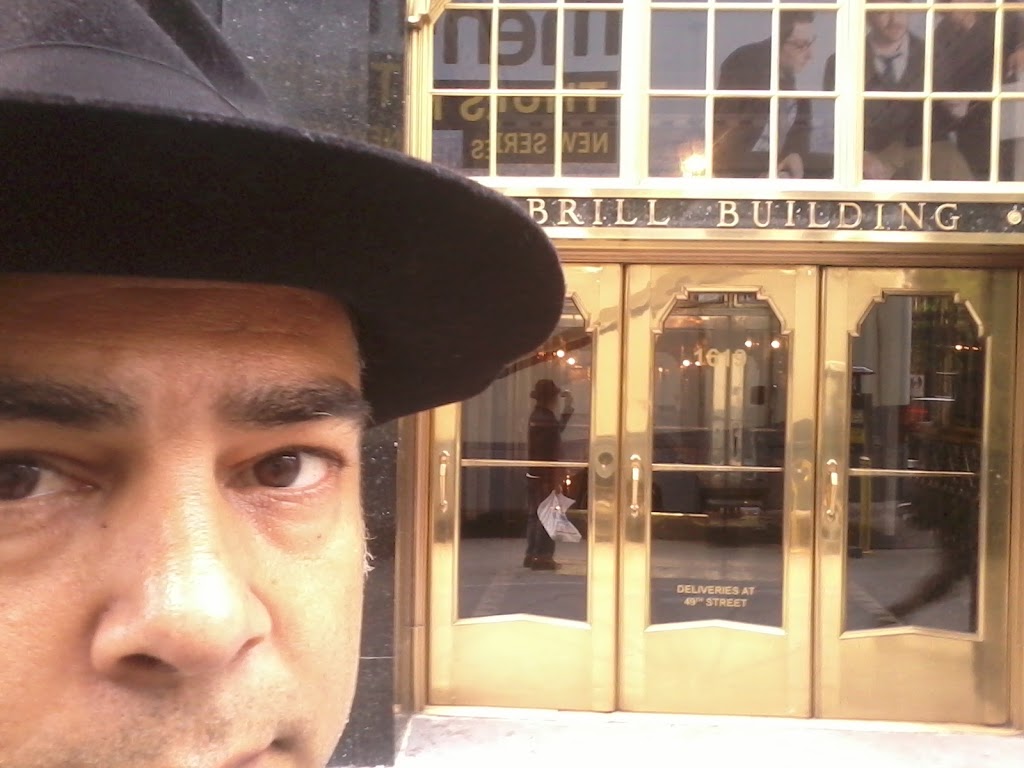
That is me outside of the Brill Building. I passed by it as I was leaving Colony at Broadway and 50th. This time I am going to remember where it is. It is one of those legendary NY buildings that I keep misplacing only to have it unexpectedly pop up again.
I was hunting for manuscript paper. It has all but disappeared with the advent of online printable music paper. One would think that if someone was creating a piece of music that they would want the document to be a object of art itself.
I remember seeing Cecil Taylor at the Village Vanguard and peering at his manuscript as it sat unattended at the piano. Torn and tattered, smeared with pencil marks, diagrams, charts and arrows offering scant guidance through it’s impenetrable maze. It was like some holy document that had been rescued from a cave in Jerusalem.
I wonder what somebody like Phillip Glass or Steve Reich does? Do they special order bound, acid free books from the last distributor on earth? I am told that it is Judy Green in California.
Hunting around Times Square I got a glimpse of its past glory when it was the northern-most arrondissement of Tin Pan Alley. Colony Records, right next to the Brill Building. Dowling Music, just above the magnificent Steinway Hall and a stones throw from Carnegie Hall. Franks Music, hidden away on the tenth floor of an obscure building filled with rehearsal halls, The Bridge Theater company and a flamenco dance troop. A place where a little bell tinkled as you entered its dusty archives.
I got a discount on a gum bound book of cream colored stave paper at Colony. It’s cover, torn off long ago, it had lain at the bottom of a drawer for who knows how many decades. I am hoping it is acid free. Already Kosi is illuminating it with her magnificent script.
More News
Recently I was asked to write a statement regarding the my space opera. There is the remote possibility that we might be included in this years opera festival in Bremen, Germany. Complete text follows:
Kepler 22B. Statement
The initial concept for Kepler 22b first came to me as a matter of ambition. I was watching The Rolling Stones “Rock and Roll Circus”, an obscure video from the late 1960s that had rëemerged in the 1990s after languishing for decades in a barn in upstate NY.
The Stones had shelved it after a dazzling performance by The Who, whom had just returned from touring. The Who performed a 7 minute piece entitled “A Quick One While He’s Away” that is essentially a miniature Opera.
It fascinated me to see this sectional piece of work, that was years later to be included in their grand opus, Tommy. It inspired me to attempt something similar.
I began searching for a theme. A news article about the discovery of a “habitable” planet 600 light years away, filtered through to me. I began to work on a synopsis about a journey to such a place, who would go, how they would travel and why.
The first draft of the resulting tale was completed in Frankfurt Germany during the winter of 2012. It is the story of Noah Blumstein, a young worker burdened with astronomical student debt. He is doomed to a life of labor as a cog in the corporate American machine.
He assuages his misery by volunteering for a local animal shelter and loses himself in the task of refurbishing a mysterious steam-punk device. That machine has lain dormant for decades at the top of the skyscraper at 100 Commerce St. where he is employed. That building, built at the dawn of the 20th century, largely with manpower is more akin to the pyramids than contemporary structures and similar mysteries lie within.
His life is changed when he meets Akuba, a descendant of African slaves and a present day cabaret singer. Their turbulent romance of seduction and rejection begins. She wears an amulet passed down from her great-grandmother that bears the crystal which is The missing component of Noah’s machine. When he wins her, he wins the stone.
Together, with the aid of the completed astral-projection device, they gather the animals of the earth, shed their corporeal selves and travel together to found a new world on Kepler 22b.
The opera covers a variety of downtown New York locations and a wide swath of musical genres including; metal, blues, jazz, gospel, funk and soul. Quickly it has expanded from its original concept of 10 minutes to 45 with perhaps more to come. It has been one of those rare creative experiences where everything in one’s life can be poured into a single vessel. I look forward to sharing it with you.
Kind regards.
Rene Calvo, Harlem NYC, Spring 2012

